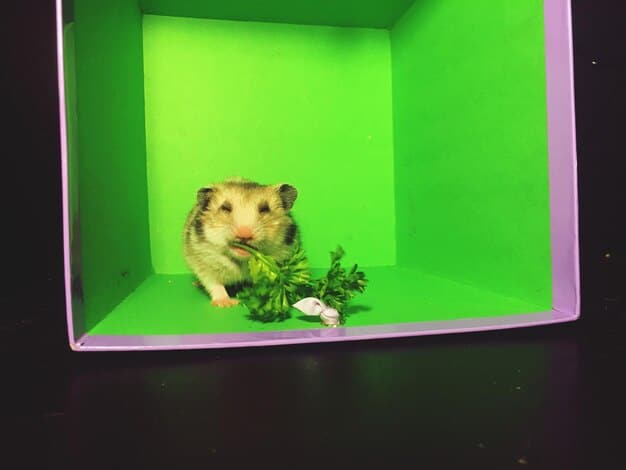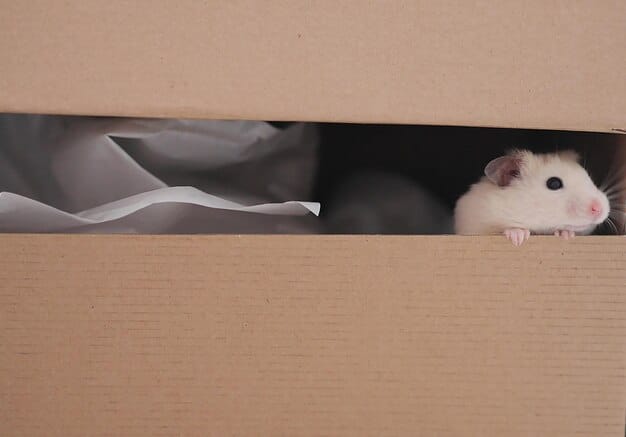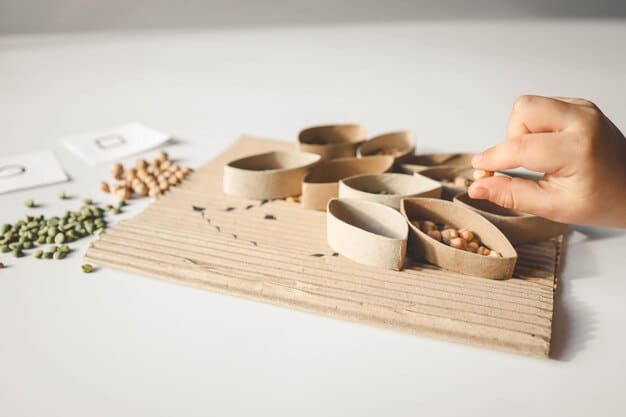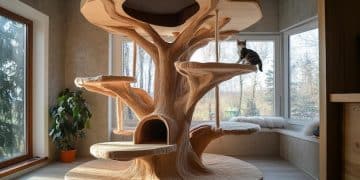Create a DIY Hamster Maze: Fun Project for Your Hamster

Anúncios
Creating a DIY hamster maze is a fun and engaging project to enrich your small pet’s life by providing mental stimulation and physical activity, using easily accessible materials that allow for customization and creativity.
Looking for a fun and enriching activity for your furry friend? Why not create a DIY hamster maze? It’s a fantastic way to provide mental stimulation and physical exercise, keeping your hamster happy and entertained.
Anúncios
Why Build a DIY Hamster Maze?
Building a maze isn’t just a fun project for you; it’s incredibly beneficial for your hamster. Mazes encourage natural behaviors like exploring and foraging, which are vital for their well-being.
Hamsters are naturally curious and active creatures. A well-designed maze can provide hours of entertainment and exercise, helping to prevent boredom and obesity.
Anúncios
Mental and Physical Stimulation
A maze challenges your hamster to think and problem-solve. This mental stimulation is crucial for preventing boredom and promoting cognitive health.
Navigating a maze provides essential physical activity, helping your hamster stay in shape and burn off excess energy. This is particularly important for hamsters living in cages with limited space.
Customization and Creativity
One of the best things about building a DIY maze is the freedom to customize it to your hamster’s preferences and your own creative vision. You can design the maze to be as simple or complex as you like, using a variety of materials and obstacles.
- Variety of Materials: Use cardboard boxes, tubes, and even safe plastic containers.
- Obstacles and Challenges: Add tunnels, bridges, and climbing structures to make the maze more engaging.
- Treats and Rewards: Hide treats throughout the maze to encourage exploration and reward your hamster’s efforts.
Ultimately, building a DIY hamster maze is a rewarding experience for both you and your pet. It’s a chance to bond, get creative, and provide your hamster with a stimulating and enjoyable environment.
Essential Materials for Your Hamster Maze
Before you start building, it’s essential to gather the right materials. Safety is paramount, so choose items that are non-toxic and won’t harm your hamster if chewed.
Here’s a list of must-have materials to get you started on your DIY hamster maze project.

Safe and Non-Toxic Materials
Always prioritize your hamster’s safety when selecting materials. Avoid anything with sharp edges, small parts that could be ingested, or toxic chemicals.
Cardboard is generally safe, but ensure it’s clean and free of staples or tape. Look for non-toxic glue or tape specifically designed for pet projects.
Key Materials Checklist:
- Cardboard Boxes: Various sizes for creating different sections of the maze.
- Cardboard Tubes: Toilet paper or paper towel rolls for tunnels and pathways.
- Non-Toxic Glue/Tape: For securely attaching maze components.
- Scissors/Craft Knife: For cutting and shaping materials.
Gathering the right materials is the first step to creating a fun and safe maze for your hamster. With these items, you’ll be well on your way to designing an exciting and enriching environment for your furry friend.
Step-by-Step Guide to Building Your Maze
Now that you have your materials, let’s get to the fun part: building the maze. Follow these steps to create a stimulating and safe environment for your hamster.
Each step is designed to ensure your maze is both engaging and secure for your pet.
Planning Your Maze Design
Before you start cutting and gluing, take some time to plan your maze design. Consider the size of your hamster and the available space.
Sketch out a rough layout of the maze, including different sections, tunnels, and obstacles. This will help you visualize the final product and ensure a smooth building process.
Construction Steps:
- Cut and Shape: Use scissors or a craft knife to cut cardboard boxes into the desired shapes and sizes.
- Assemble the Maze: Attach the different sections together using non-toxic glue or tape. Ensure all connections are secure.
- Add Tunnels and Obstacles: Incorporate cardboard tubes, small wooden blocks, or other hamster-safe items to create tunnels and challenges.

By following these steps, you’ll be able to construct a fantastic maze that provides both mental and physical stimulation for your hamster. Remember to prioritize safety and have fun with the design process!
Adding Engaging Elements to Your Hamster Maze
A basic maze is a good start, but adding engaging elements will make it even more stimulating for your hamster. Consider incorporating different textures, challenges, and hiding spots.
These additions will encourage your hamster to explore and interact with the maze in new and exciting ways.
Enhancing the Maze Experience
Different textures can provide sensory enrichment. Try adding small pieces of safe fabric or rough cardboard to different sections of the maze.
Challenges such as climbing structures or hidden treat compartments can also keep your hamster engaged and entertained.
- Texture Variety: Incorporate different materials for sensory stimulation.
- Climbing Structures: Add small, stable structures for climbing.
- Hidden Treats: Create compartments for hiding treats, encouraging foraging behavior.
By adding these engaging elements, you can transform a simple maze into an enriching and stimulating environment for your hamster. These additions will keep your pet entertained and encourage natural behaviors.
Safety Tips for Your DIY Hamster Maze
While building a DIY maze can be a fun and rewarding project, safety should always be your top priority. Here are some essential safety tips to keep in mind.
Ensuring the maze is safe will prevent injuries and keep your hamster healthy and happy.
Prioritizing Hamster Safety
Regularly inspect the maze for any damage or wear and tear. Replace any damaged components immediately to prevent injuries.
Avoid using small items that could be ingested, and always supervise your hamster during its first few maze explorations.
Important Safety Guidelines:
- Check for Damage: Regularly inspect the maze for any sharp edges or loose pieces.
- Supervise Initial Explorations: Monitor your hamster during its first few maze sessions to ensure its safety.
- Non-Toxic Materials: Only use materials that are safe for hamsters to chew and ingest.
By following these safety tips, you can ensure that your DIY hamster maze is not only fun but also safe for your furry friend. A safe maze is a happy maze!
Maintaining and Cleaning Your Hamster Maze
Proper maintenance and cleaning are essential for keeping your hamster maze hygienic and safe. Regular cleaning will prevent the buildup of bacteria and ensure a healthy environment for your pet.
Here’s how to keep your maze in top condition.
Regular Cleaning Practices
Wipe down the maze with a damp cloth regularly to remove any dirt or debris. For more thorough cleaning, use a mild, hamster-safe disinfectant.
Replace any soiled bedding or nesting materials promptly to prevent odors and bacterial growth.
- Regular Wiping: Clean the maze with a damp cloth weekly.
- Disinfectant Use: Use a hamster-safe disinfectant for thorough cleaning.
- Bedding Replacement: Replace soiled bedding and nesting materials frequently.
By following these maintenance and cleaning practices, you can keep your hamster maze clean, safe, and enjoyable for your furry friend. A clean maze is a happy and healthy maze!
| Key Point | Brief Description |
|---|---|
| 🛠️ Material Safety | Use non-toxic materials only. |
| 🧠 Mental Stimulation | Mazes prevent boredom and encourage problem-solving. |
| 🤸 Physical Activity | Helps hamsters stay active and prevent obesity. |
| 🧼 Regular Cleaning | Keeps the maze hygienic and prevents bacterial growth. |
Frequently Asked Questions
▼
Safe materials include clean cardboard, non-toxic glue, and hamster-safe wooden toys. Avoid anything with sharp edges or small parts that could be ingested.
▼
Wipe down the maze with a damp cloth weekly. For a more thorough cleaning, use a hamster-safe disinfectant monthly and replace soiled bedding promptly.
▼
Place treats throughout the maze to encourage exploration. Gradually increase the complexity of the maze as your hamster becomes more comfortable with it.
▼
If your hamster chews on the maze, ensure that all materials are non-toxic. Regularly inspect the maze for damage and replace any unsafe components immediately.
▼
Add different textures, climbing structures, and hidden treat compartments to keep your hamster entertained. Rotate the elements periodically to maintain interest.
Conclusion
Creating a DIY hamster maze is a fantastic project that provides numerous benefits for your furry friend. By using safe materials, following the building instructions, and prioritizing safety and maintenance, you can create an engaging and stimulating environment that will keep your hamster happy and healthy.






